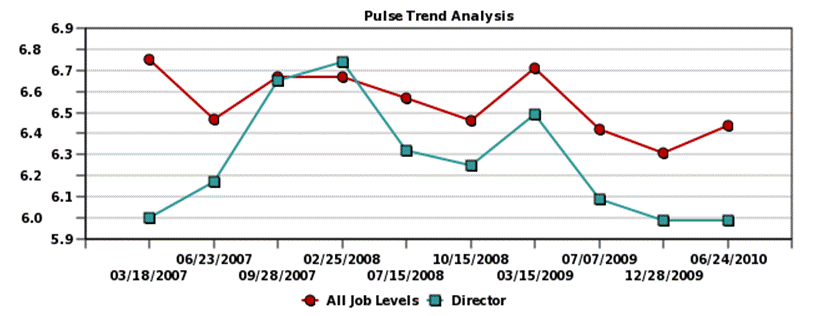This edition of “From the Energy Files” comes from data we have been collecting in the Leadership Pulse™ project. Since 2003, we have been sending short pulse surveys out to a sample of leaders around the world.
The pulsing work started with the alumni from the University of Michigan’s Executive Education program, and since our beginning, new leaders, and managers have joined, changed jobs, and continued to engage in the sharing of information for the purpose of learning.
In each of the Leadership Pulse surveys, we ask respondents to report on their energy at work and then discuss one other topic. The key topic changes with each rendition of the Leadership Pulse.
Our goal is less about benchmarking and survey taking and more focused on learning from each other. The reason for this type of ongoing, real-time learning is that business is changing quickly, and by the time you do extensive research, write it up, and then publish an article or book, years and years go by. The Leadership Pulse is an effort to shortcut that process by engaging leaders in interactive dialogues about what’s happening to them and their companies.
Example: The Director Level Effect
Over the last year, we collected several sources of data that point to a “director effect.” When looking at the data by job level (e.g. C-level vs. VP level vs. Director vs. Manager), we saw that the people at the director level were reporting information that sounded off an alarm to our research team. In one of the reports we called it the “neglected warrior syndrome.” The story goes something like this:
Director level is working very hard to keep the company moving forward and successful in the recession. They have taken on a lot of responsibility; they are managing the people who report to them, but they are not at high enough of a level in the organization to have access to all the information they need. They are not part of the strategic decision making process, and they are not confided in when big decisions are being made. Employees wonder what’s going on, they go to the directors, and they don’t have the information, but they are good leaders and help employees get through. The directors have worked hard, and their peers notice them. The directors are doing a lot of good work, but their leaders are NOT noticing them. The headhunter calls the directors’ peers or friends from other companies, and the director name is provided. Directors are being “poached.”
There are numerous data points that lead to the story above; however, here I present just one. Below you will find energy trend data for the respondents at the director level from the Leadership Pulse survey. What you see is the gap between the director level (green line) and the overall sample (red line), with the director level energy plummeting down.
What you see is the gap between the director level (green line) and the overall sample (red line), with the director level energy plummeting down.
Below is a copy of the energy scale to understand what we are measuring. We ask everyone to rate their energy at work, and we also ask them to rate where they are most productive. These director level scores have not been “in the productivity zone” for any of the dates noted in the graph above. Their productivity zone (calculated using the number respondents report as being most productive) is between 7.35 and 8.75. Thus, the director level is not only going down, but it is below where directors say they are most productive. This means they are not as productive as they can be, adding to the organization’s problem because they are losing productivity from this group of employees.
There’s more background data I could provide; however, I want to move on to what’s probably more important. What do you do about it? What can a leader do to help bring the directors, and other employees, into their productivity zones and help retain this talent?
Direction is a Good Starting Point
Below you will find some sample comments from these director-level respondents:
- “Most energized when. . . compelling and inspirational vision exists, when resources, goals and organizations are aligned so that optimal results for customers happen.”
- “Challenging projects with deadlines really charge up my energy level.”
- “I am feeling like I am spinning wheels in getting things done”
- “I am the most energized when I feel that my work is aligned with the strategic direction of my department; and when I see concrete evidence that my department’s vision is aligned with the larger organizational strategy.”
With over 1 million data points on employee energy, including comments about what’s making energy go up and down, we continue to hear this request – the need for direction. Even though directors are higher up in the chain of command, they too want some help. Energy alone is not enough; employees want to know where to exert their energy so that they are doing the right work at the right time to meet the company goals.
If the director levels needs direction, then you know the people at levels below director must be feeling the same way. The lack of direction is not coming from lack of strategy so much as it’s a function of ever-expanding work projects.
In several other articles I’ve written on this topic, I describe something called “stacking work syndrome.” People at work have stacks, and they just keep getting bigger. It’s beyond their ability to reduce all these stacks, so they work a little bit on each one to make the stakeholders of each stack somewhat happy. But the lack of success in getting rid of the stacks is demoralizing. Direction leads to stack reduction, and then by completing tasks, employees feel a sense of accomplishment.
Suggested Actions
Check in with your directors and managers; find out how energized they are at work. There continues to be a lot of talk about employees being the most important asset, but most firms do not systematically measure or track how employees are doing A once-a-year employee survey with questions that probably are not, as they say, “spot on” is not proactive in a high change environment.
High quality management of the people asset requires trend data. Leaders need the same type of data they use to manage sales, productivity, quality, and finances. It would be unheard of to ask for a financial report once a year only and then assume for the 12 months in between all is okay. Why are there less effective processes for employee data?
What we have learned from frequent energy tracking of employees is that the data fluctuates a lot. By studying trends and responding to trend data, stacking work syndrome can be avoided. Employees, including directors, can be helped easily by a few conversations about direction. When directors are on target, they help the rest of the organization.
You manage what you measure, and we find that, unfortunately, we also ignore what’s not making a lot of noise. The directors have been quietly helping firms succeed during the recession. To keep them from leaving and becoming more successful elsewhere, take action today.
Editor’s Note: What are the Energy Files? Over 1 million data points on employee energy at work and open-ended comment data on what is making energy increase and decrease. The raw data, the research studies, and case studies make up the Energy Files. To learn more go to www.leadershippulse.com or www.eepulse.com.
